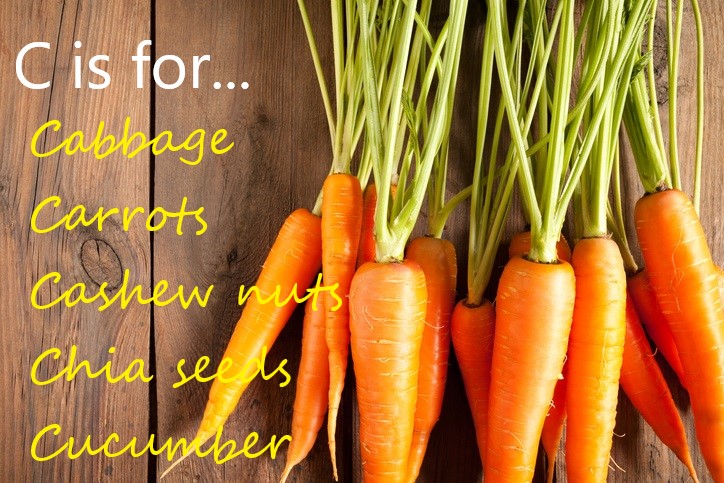Healthy Alphabet: C is for…Five Foods that are Good for You
by Karen Rollins Mar 4, 2019

We are constantly bombarded with information about what we should and shouldn’t be eating which can become confusing.
Yello has decided to go for a simple approach and provide an alphabetical guide to some of the healthiest foods you can add to your diet.
We’ll be going from A-Z and listing five fruits and vegetables that are packed with minerals and vitamins while also providing nutritional facts on their health benefits.
We’ve already covered A and B, so now let’s get on to C.
Cabbage
It may not be everyone’s favourite vegetable but there’s no doubt that cabbage is extremely good for you and it can be nice to eat when it’s not overcooked.
Cabbage is part of the cruciferous family of vegetables, like kale and broccoli, which are known for being crammed full of beneficial vitamins and nutrients.
It also contains various antioxidants including choline and beta carotene although these are more prevalent in red cabbage than green cabbage.
Nutrition facts (1 head)
– 218 calories
– 4 grams of carbohydrate
– 11 grams of protein (22% of daily value (DV))
– 136 milligrams (mg) of magnesium (72% DV)
– 463 mg of vitamin C (772% DV)
– 518 micrograms (mcg) of folate
– 2234 mg of potassium (64% DV)
– 427 mg of calcium (43% DV)
Carrots
Carrots have several health benefits whether they are eaten raw, juiced into a refreshing drink or cooked.
They provide a well-rounded influx of vitamins and minerals and are believed to help reduce cholesterol, cut the risk of a heart attack, help prevent certain cancers, improve vision and reduce signs of premature aging.
Carrots get their orange colour from antioxidants called carotenoids which are known to boost the body’s immune system.
Nutrition facts (1 cup):
– 52 calories
– 3.6 grams of dietary fibre
– 12.5 grams of carbohydrates
– 1069 mcg of vitamin A (428% DV)
– 42 mg of calcium
– 0.38 mg of iron
– 15 mg of magnesium
– 45 mg of phosphorus
Cashew nuts
Cashews are one of the lowest-fibre nuts, but they are full of essential vitamins such as vitamin K and minerals like copper, zinc, and iron.
Cashews are also a good source of magnesium, which plays an important role in several functions within the body including the metabolism of food.
Nutrition facts (approx. 18 cashews):
– 155 calories
– 9.2 grams of carbohydrates
– 1.7 grams of sugar
– 0.9 grams of fibre
– 5.1 grams of protein (10% DV)
– 81.8 mg of magnesium (20% DV)
– 166 mg of phosphorous (17% DV)
– 9.5 mcg of vitamin K (12% DV)
Chia seeds
Chia seeds have become popular in recent years as a health food staple, but they’ve actually been used for centuries in Aztec and Mayan diets, and there’s even evidence of them being consumed as early as 3500 BC.
They are an excellent source of antioxidants, fibre, iron and calcium as well as Omega-3 fatty acids, which help raise HDL cholesterol, the ‘good’ cholesterol that protects against heart attacks and strokes.
Nutrition facts (1 ounce):
– 137 calories
– 10.6 grams of dietary fibre (42% DV)
– 12.3 grams of carbohydrates
– 4.4 grams of protein
– 4915 milligrams of Omega-3 fatty acids
– 265 mg of phosphorous (27% DV)
– 0.6 mg of manganese (195% DV)
– 177 mg of calcium (18% DV)
Cucumber
Cucumbers, which are actually a fruit and not a vegetable, are low in calories and rich in two of the most basic elements needed for healthy digestion; water and soluble fibre.
They also contain multiple B vitamins, including vitamin B1, B5 and B7. B vitamins are proven to help ease feelings of anxiety and negate some of the damage caused to the body by stress.
Nutrition facts (one cup of peeled cucumber):
– 16 calories
– 0.8 grams of protein
– 0.9 grams of dietary fibre
– 9.6 mcg of vitamin K (12% DV)
– 4.3 grams of vitamin C (7% DV)
– 181 mg of potassium (5% DV)
– 18.6 mg of calcium (2% DV)
– 16 mg of magnesium (4% DV)
Watch out for the rest of the healthy food alphabet in this series to be published on Find Yello, and click to take a look at the previous A and B articles.
Sources: The Food Coach / Draxe / Medical News Today / Organic Facts / Nutrition Data








